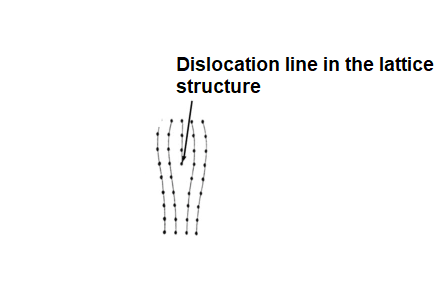1. Dislocations: What Are They? What makes them significant in metals and alloys? By drawing a 2D ball and stick model, you can highlight the key characteristics of an edge dislocation, including the extra-half plane, dislocation center, slip plane, sense vector, and Burgers vector. 2.What are the Burgers and sensation (dislocation line) vectors used for? Please answer all with full detail
1. Dislocations: What Are They? What makes them significant in metals and alloys? By drawing a 2D ball and stick model, you can highlight the key characteristics of an edge dislocation, including the extra-half plane, dislocation center, slip plane, sense vector, and Burgers vector.
2.What are the Burgers and sensation (dislocation line)
Please answer all with full detail
Dislocations:
Dislocations are defects in the crystal lattice structure of metals and alloys. They are essentially a line or a plane in the crystal lattice where the atoms are out of place, which causes a disruption in the regular arrangement of atoms.
Significance of Dislocations:
- Dislocations are significant in metals and alloys because they can cause plastic deformation, or the ability of the material to permanently deform without breaking.
- When a metal or alloy is subjected to external stresses, dislocations can move through the crystal lattice, allowing the material to deform without breaking.
- This process is essential for many engineering applications, such as forming metals into complex shapes or creating durable structural components.
- Dislocations also play a significant role in the mechanical properties of metals and alloys. The presence and movement of dislocations can affect the strength, ductility, and toughness of a material.
- The concentration and distribution of dislocations can also affect the behavior of the material under different types of stresses.
2D ball and stick model:
In this model, the balls represent atoms and the sticks represent the bonds between them.
An edge dislocation is characterized by an extra half-plane of atoms in the crystal lattice structure. This extra half-plane creates a boundary between the displaced and undisturbed regions of the crystal lattice, which is called the dislocation center.
The slip plane is the plane along which the dislocation moves when subjected to external stresses. The sense vector represents the direction in which the dislocation moves through the crystal lattice.
The Burgers vector represents the magnitude and direction of the atomic shuffling that occurs when the dislocation moves through the crystal lattice. The Burgers vector is perpendicular to the slip plane and points in the direction of the sense vector.
To illustrate this with a 2D ball and stick model, imagine a rectangular crystal lattice with atoms arranged in rows and columns. A line is drawn between two adjacent rows of atoms, and one half of the lattice is shifted along this line. This creates an extra half-plane of atoms that forms the dislocation center.

The slip plane is the plane perpendicular to the dislocation line and parallel to the extra half-plane. The sense vector is the direction along the dislocation line, and the Burgers vector is the vector connecting the displaced atoms in the extra half-plane.
Overall, the ball and stick model can help illustrate the key characteristics of an edge dislocation, including the extra-half plane, dislocation center, slip plane, sense vector, and Burgers vector. Understanding these characteristics is important for understanding the behavior of dislocations in metals and alloys.
Trending now
This is a popular solution!
Step by step
Solved in 2 steps with 1 images









